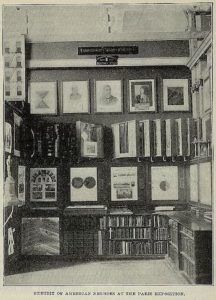
Worlds Fair Exhibit (1900)
*On this date in 1900, The Exhibit of American Negroes was shown at the Paris Exposition. This was a sociological display at the Paris Palace of Social Economy at the 1900 World's Fair.
The exhibition's goal was to demonstrate progress and commemorate the lives of African Americans at the turn of the century. The exhibit included a statuette of Frederick Douglass, four bound volumes of nearly 400 official patents by African Americans, photographs from several educational institutions (Fisk University, Howard University, Roger Williams University, Tuskegee Institute, Claflin University, Berea College, North Carolina A&T), an African-American bibliography by the Library of Congress containing 1,400 titles, and two social studies directed by Du Bois: "The Georgia Negro" (comprising 32 handmade graphs and charts), and a set of about 30 statistical graphics on the African American population made by his students at Atlanta University.
Most memorably, the exhibit displayed five hundred photographs of African American men and women, homes, churches, businesses, and landscapes, including photographs from Thomas E. Askew and Mary H. Dickerson. The exhibit was a joint effort between Daniel Murray, the Assistant Librarian of Congress, Thomas J. Calloway, a lawyer and the primary organizer of the exhibit, and W. E. B. Du Bois. Calloway sent a letter to over one hundred Black representatives in various sections of the United States to solicit help in advocating for an exhibit to present at the World's Fair in Paris. The letter insists that "thousands upon thousands will go [to the fair], and a well-selected and prepared exhibit, representing the Negro's development in his churches, his schools, his homes, his farms, his stores, his professions, and pursuits, in general, will attract attention... and do a great and lasting good in convincing thinking people of the possibilities of the Negro."
Washington personally appealed to President William McKinley, and just four months before the opening of the Paris Exposition, Congress allocated $15,000 to fund the exhibit. The exhibit was separate from the United States national building, within the shared space of the Palace of Social Economy and Congresses, with maps detailing U.S. resources, New York City tenement models, and information on labor unions, railroad pensions, and libraries. It was displayed from April to November 1900, and over 50 million people passed through.
Mainstream American newspapers generally ignored the existence of the Negro Exhibit, and the U.S. commissioner-general failed to mention the Negro Exhibit in his comprehensive article published in the North American Review. Still, the Negro Exhibit occupied one-fourth of the total exhibition space allocated to the US in the multinational Palace of Social Economy and Congresses. Black periodicals like The Colored American wrote extensively about the project. Today the Exhibit of American Negroes is housed at the Library of Congress.